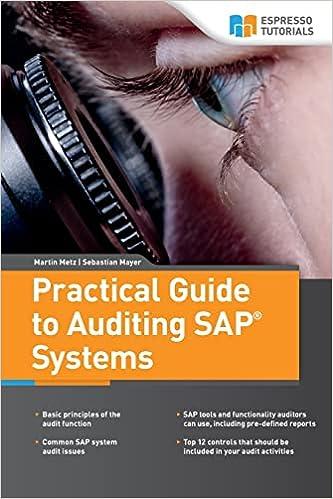Question
Statement of Cash FlowsDirect Method applied to PR 16-1A The comparative balance sheet of Navaria Inc. for December 31, 20Y3 and 20Y2, is as follows:
Statement of Cash FlowsDirect Method applied to PR 16-1A The comparative balance sheet of Navaria Inc. for December 31, 20Y3 and 20Y2, is as follows: Dec. 31, 20Y3 Dec. 31, 20Y2 Assets Cash $ 248,860 $ 235,700 Accounts receivable (net) 91,600 84,040 Inventories 258,190 248,260 Investments 0 96,600 Land 132,340 0 Equipment 282,170 222,180 Accumulated depreciation-equipment (67,100) (59,900) Total assets $946,060 $826,880 Liabilities and Stockholders' Equity Accounts payable $ 171,050 $ 162,900 Accrued expenses payable 17,200 21,500 Dividends payable 9,300 7,400 Common stock, $1 par 50,500 38,860 Excess of paid-in capital over par 192,300 112,460 Retained earnings 505,710 483,760 Total liabilities and stockholders equity $946,060 $826,880 The income statement for the year ended December 31, 20Y3, is as follows: Sales $1,570,720 Cost of merchandise sold 965,990 Gross profit $ 604,730 Operating expenses: Depreciation expense $ 7,200 Other operating expenses 512,050 Total operating expenses 519,250 Operating income $ 85,480 Other income: Gain on sale of investments 16,100 Income before income tax $ 101,580 Income tax expense 40,630 Net income $ 60,950 Additional data obtained from an examination of the accounts in the ledger for 20Y3 are as follows: The investments were sold for $112,700 cash. Equipment and land were acquired for cash. There were no disposals of equipment during the year. The common stock was issued for cash. There was a $39,000 debit to Retained Earnings for cash dividends declared. Required: Prepare a statement of cash flows, using the direct method of presenting cash flows from (used for) operating activities. Use the minus sign to indicate cash outflows, cash payments, decreases in cash, or any negative adjustments. Navaria Inc. Statement of Cash Flows For the Year Ended December 31, 20Y3 Cash flows from (used for) operating activities: blank Cash received from customers $Cash received from customers Cash paid for merchandise Cash paid for merchandise Cash paid for operating expenses Cash paid for operating expenses Cash paid for income taxes Cash paid for income taxes Net cash flows from operating activities blank $fill in the blank 9 Cash flows from (used for) investing activities: blank Cash received from sale of investments $Cash received from sale of investments Cash paid for purchase of land Cash paid for purchase of land Cash paid for purchase of equipment Cash paid for purchase of equipment Net cash flows used for investing activities blank fill in the blank 16 Cash flows from (used for) financing activities: blank Cash received from issuing common stock $Cash received from issuing common stock Cash dividends Cash dividends Net cash flows from financing activities blank fill in the blank 21 Net increase in cash blank $Net increase in cash Cash balance, January 1, 20Y3 blank fill in the blank 24 Cash balance, December 31, 20Y3 blank $fill in the blank 25
Step by Step Solution
There are 3 Steps involved in it
Step: 1

Get Instant Access to Expert-Tailored Solutions
See step-by-step solutions with expert insights and AI powered tools for academic success
Step: 2

Step: 3

Ace Your Homework with AI
Get the answers you need in no time with our AI-driven, step-by-step assistance
Get Started


